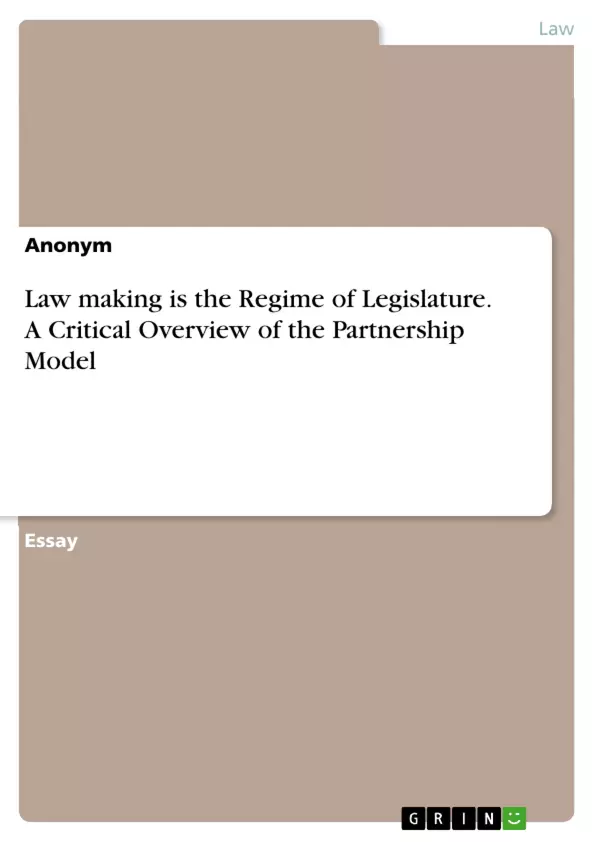The main topic of this paper is to frame a critique of the so-called partnership model in jurisdiction between the legislature and the judiciary-
The hallmark of 19th and 20th century doctrines of interpretation has been that they premise themselves on the principle that a court ought to interpret law as it stands. The function of the court is to interpret the language of a statute, whereas it is for the legislature to make enactments and for the courts to enforce such enactments. Courts are not legislators, they have to carry out loyally the directions of the legislature. Two models of interpretation stands in present world, agency and partnership model. According to the agency model while interpreting a statute, the Court has to discover the intent of the legislature or the purpose behind legislation. The partnership model views the Court as a partner in legislative enterprise with legislature, hence, while interpreting a statute the Court should seek a sensible to avoid rigors of law. Judge does not create normative text but rather gives it meaning. The static vision of statutory interpretation prescribed by traditional doctrine is strikingly outdated. Interpretation of a statute evolves over time because of changing factual contexts and the changing perspectives of its interpreters. Statutory interpretation should appropriately balance a number of factors, including predictability and certainty, economic efficiency, fairness, and the public interest.
Inhaltsverzeichnis (Table of Contents)
- I. ABSTRACT
- II. INTRODUCTION.
- A.THEORITICAL APPROACH:
- B. HISTORICAL OVERVIEW OF STATUTORY INTERPRETATION:
- a. EARLY YEARS OF NATURAL LAW AND FORMALISM:
- b. 20TH CENTURY; RISE OF LEGAL REALISM:
- c. MODERN JURISPRUDENCE: RESPONDING TO LEGAL REALISM:
- III. BODY OF REPORT.
- A. LAW MAKING IS THE REGIME OF LEGISLATURE
- LORD COKE'S FORMULATION:
- B. CRITICAL OVERVIEW OF THEORIES OF INTERPRETATION OF STATUTES:
- 1. AGENCY MODEL: COURTS AS AGENTS OF LEGISLATURE.
- 2. TRADITIONAL INTENTIONALISM
- 3.AGENTS OF A PRINCIPAL WITHOUT INTENT
- 4. PURPOSIVISM V. TEXTUALISM: IN PRACTICE A CLEAR DISTINCTION:
- C. PARTNERSHIP MODEL: COURTS AND LEGISLATURES AS LAW MAKING PARTNERS:
- 1. INDEPENDENT JUDICIAL DECISION:
- 2. DYNAMIC STATUTORY INTERPRETATION;.
- 3. PRAGMATISM.
- 4. LEGISLATIVE SUPREMAC
- IV. CONCLUSION:
Zielsetzung und Themenschwerpunkte (Objectives and Key Themes)
This report provides a critical overview of the partnership model in statutory interpretation, examining the historical development and theoretical foundations of this approach. The report focuses on the interplay between legislatures and courts in shaping the law and explores the implications of viewing courts as partners in the legislative enterprise.
- The Role of the Legislature in Lawmaking
- Historical Evolution of Statutory Interpretation Theories
- Agency and Partnership Models of Statutory Interpretation
- The Dynamic Nature of Statutory Interpretation
- The Balance Between Legislative Intent and Judicial Discretion
Zusammenfassung der Kapitel (Chapter Summaries)
- I. ABSTRACT: This section provides an overview of the key arguments presented in the report, emphasizing the significance of the partnership model in contemporary statutory interpretation.
- II. INTRODUCTION: This chapter examines the theoretical and historical context of statutory interpretation, exploring the concept of the separation of powers and the evolution of legal thinking from natural law to legal realism.
- III. BODY OF REPORT: This chapter delves into the heart of the report, examining the partnership model of statutory interpretation in detail. It contrasts the partnership model with the traditional agency model, exploring the arguments for and against each approach.
Schlüsselwörter (Keywords)
The key concepts and terms explored in this report include statutory interpretation, partnership model, agency model, legislative supremacy, judicial discretion, legal realism, natural law, and separation of powers.
- Citar trabajo
- Anonym (Autor), 2021, Law making is the Regime of Legislature. A Critical Overview of the Partnership Model, Múnich, GRIN Verlag, https://www.grin.com/document/1006532



